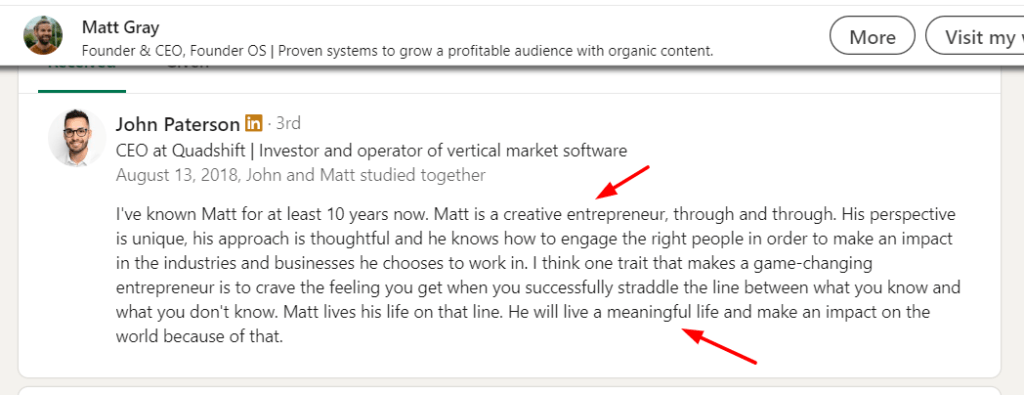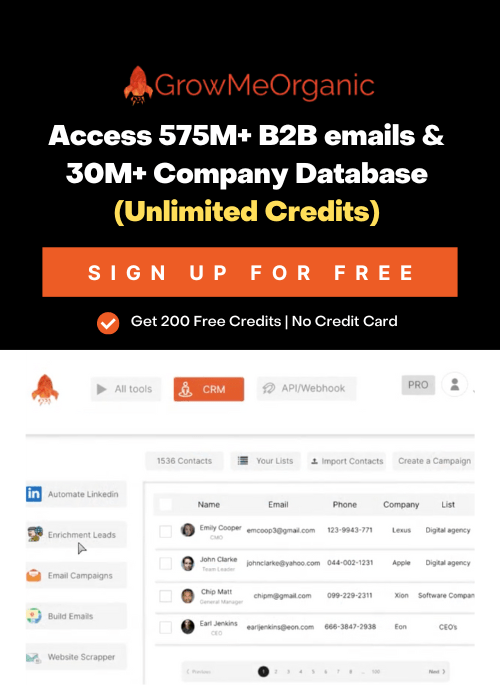Do LinkedIn recommendations that truly make your profile pop? Well, it’s no secret – standout recommendations truly catch the eye more than cookie-cutter phrases do.
If you’re looking to climb the ranks in recruiter searches, recommendations on your LinkedIn can be your best friend. They give potential employers, clients, or leads a real insight into who you are.
Been laid off recently? A solid LinkedIn recommendation could be the silver lining you need. But, remember, don’t treat LinkedIn recommendations lightly.
Tempted to have AI or ChatGPT whip up a quick recommendation? Think twice. Missing that personal flair can really turn off a recruiter. Ready to nail that perfect recommendation? Follow these top 10 best LinkedIn recommendation examples and start making a mark.
Why Should I Write A LinkedIn Recommendation?
Imagine you’re leaving a great review for someone online but on LinkedIn. This feature lets you write about people you’ve worked with, kind of like giving them a shout-out.
HR folks often check these out to decide who to call for an interview. It’s like a mini-backup, vouching for your skills and work history.
Why even write one? It’s simple. It shows you care and helps get the word out about someone you think is great to work with. Plus, it makes you look good, too, by showing you’re a team player. Short, sweet, and to the point!
How to Request a Recommendation For LinkedIn
Here’s how to request a LinkedIn recommendation from someone.

- Go to a LinkedIn user’s profile.
- Click on the message icon at the top right of their profile and choose “Request recommendation.”
- Type a custom message to engage your network about how you know each other and why you feel he/she deserves a recommendation.
- Send it!
Here are some LinkedIn recommendation sample ideas that can be used when requesting a recommendation:
- “Your insights into A, B, and C were helpful to me when I was working on the X project management. Please help me in presenting that experience so I can demonstrate my abilities to a potential employer. “
- “I requested this recommendation because of your expertise in X, Y, and Z. Can you also recommend Z for me? I’m looking for a new opportunity as well. “
- “Please help me out with my request for a recommendation. I want to demonstrate my experience working on the X project. I would highly appreciate your support “
People usually request recommendations and use LinkedIn’s default message. But I always prefer a personal message, as it increases the chances of getting responses.
Use a text expander to store some personalized templates that you can use repeatedly.
Here are a few contextual ideas that you can use in your recommendation request:
- An update on a project or task that the two of you were working on together.
- A request to recommend someone else in addition to yourself.
- An update on a project or task that the two of you were working on together.
Some LinkedIn profiles will display a “Send an InMail” button; it means that the person allows LinkedIn members.
10 Best LinkedIn Recommendations Examples You Should Note
Sample Recommendation On Linkedin For Colleagues
When recommending a colleague, highlighting their creativity, professional enthusiasm, and hardworking nature can make a strong impact. Similar to Wesley Rizal’s recommendation for Jennon, emphasizing your colleague’s specialties can add weight to your endorsement.

Linkedin Recommendation Examples For Junior Colleagues
Andrea Vitale has nothing but praise for Maureen Badura. Andrea talks about the time they’ve spent working together, highlighting Maureen’s broad understanding of managing eCommerce websites.
She makes it clear that her commendation is heartfelt, drawing from real-life experiences with Maureen. If you’re looking to draft a recommendation for your junior colleague, consider this approach, tailoring it to their unique goals and achievements.

LinkedIn Recommendation Examples For Friend
Paul Abbott recommends his friend Cheryle for her effective market strategies. After describing her professional qualities, he shares how great a team player she is.
You can also provide a specific example just like Paul stressing about Cheryle’s customer acquisition trait.

LinkedIn Recommendation Examples For Manager
When crafting a LinkedIn recommendation for a manager, emphasizing leadership qualities is crucial. Just like Benny did with Ketan, he pinpointed how Ketan thrived as a responsible leader.
Mentioning achievements like successful project completions and spotlighting unique strengths can really make the recommendation stand out.

Linkedin Recommendation Examples For Client
Emily supports the professional reputation of Arvin by focusing on his credibility as an SEO specialist. A well-crafted recommendation opens doors to new opportunities for a client, which Emily helps with by emphasizing Arvin’s result-driven activities.

Linkedin Recommendation Examples For Student
When discussing Aritra, Suman focuses on both hard achievements and soft skills. By highlighting Aritra’s academic ranking and soft skills like mentorship and communication, Suman presents a well-rounded picture of Aritra’s potential for success.

Sample LinkedIn Recommendation For HR Professional
When crafting a standout HR LinkedIn recommendation, it’s essential to highlight key HR skills, much like Vanshika does. She talks about Mahalakshmi’s strong suits, pointing out her knack for talent acquisition, her ability to boost employee relations, and her adeptness in managing performance. Also, Vanshika notes that a pleasant HR personality significantly contributes to their effectiveness.

LinkedIn Recommendation For Senior
Ben Howarth recommends his senior, Emily, by initially highlighting her exceptional interpersonal skills, recognizing the importance of being perceived as cooperative and easy to work with in a professional setting.
Following this, he references her design expertise, providing necessary context about their shared work environment to underscore her competence. Ben concludes the recommendation on a positive note, adhering to the ideal structure of such endorsements.

Recommendation For Boss Examples
“No man will make a great leader who wants to do it all himself, or to get all the credit for doing it.” – Andrew Carnegie.
We all know the importance of having the right leader. John Paterson shares Matt Gray’s unique entrepreneurial skills and thoughtful approach. He also highlights Matt’s idea of living a meaningful life, adding a personal touch.

LinkedIn Recommendation Sample For Software Developer
Kaki Sharon recommends Stephen for his QA engineering skills. From his technical capabilities to quick learning traits, he shares everything that makes him an ideal developer. You can do the same to write an impactful recommendation.

Other Creative Recommendation Ideas [ Template ]
- “I had the pleasure of collaborating with [Name] on a crucial project. His outstanding problem-solving abilities and keen eye for detail played a crucial role in its success. I wholeheartedly endorse [Name] for their commitment, professionalism, and track record of achieving results.”
- “As a manager, I can confidently say that [Name] is organized and gets things done efficiently. Her time management skills are top-notch, and she always knows how to tackle important tasks first. It keeps everything on track, and deadlines are always met.”
- “While working with us, [Name] consistently showed impressive problem-solving skills. They tackled challenges head-on, always coming up with creative and effective solutions.”
How To Say Thank You For LinkedIn Recommendation?
Always show appreciation when someone takes the time to recommend you. Whether or not you’re planning to work further with them, a simple thank you is always in good taste.
If they’re part of your professional circle, chatting about how their recommendation could play a significant role in your new position might benefit both of you.
Getting recommended holds as much weight as recommending others. Make sure to express your gratitude promptly to the person who endorses you on LinkedIn. It’s also a kind gesture to simplify their task—perhaps by providing some documents or details to ease their recommendation writing process.
Don’t forget to circle back with your recommender once they’ve submitted their endorsement. A follow-up not only shows your appreciation but keeps the professional relationship warm and engaging.
Let’s look at a few ways to thank people after getting a recommendation:
| Sl No. | Recommendation Thank You Follow Up |
| 1. | [Name], Much appreciated your recommendation. I’d love to repay your kindness. If you ever need a recommendation, I’ll happily tell people how great it was to work with you at [company]. Cheers, [Your name] |
| 2. | Thanks for the great recommendation, [Name]. I’ve had the pleasure of working with you this year. It was a real pleasure to work with you on [X project], and I learned a lot from you. I hope we can work together next time. I’m looking forward to working with you on [Y project]. |
| 3. | Thank you so much for your recommendation! It’s a real pleasure to know that we have worked together. I’m excited about working with you on [Z project]. Keep up the great work! |
| 4. | Thank you for the opportunity to work with you. It was a pleasure, and we look forward to working together again. Cheers! |
| 5. | I am deeply thankful for your recommendation, and I’m excited about joining your team and working on [Z project]. Continue doing great work! Thanks a lot! |
Few Linkedin Recommendation Tips You Shouldn’t Ignore
1. Start With a Hook
A compelling testimonial stands out by engaging the reader right from the start. One effective approach is kicking things off with an interesting story or a memorable quote that perfectly captures your abilities or character. Keep it engaging and to the point, allowing your unique personality to shine through.
2. Give Details
Instead of a paragraph that tries to describe you in one sweeping generalization, have a few paragraphs:
- 1st focuses on describing yourself
- 2nd focuses on why you love working for this company so much
- 3rd focuses on listing some of your accomplishments at this company.
3. Use a Few Vivid Examples
If the reference you are writing about is a CEO, don’t just write that you were assigned to her business unit. Instead, tell us how she asked you to lead a project and how she promoted you because of your work on that project.
4. Emphasize Their Growth
Tracking someone’s progress over time reveals a lot about how they adapt to new challenges, how quickly they learn, and how ambitious they are. It shows that they’re not stuck in one place and are motivated to grow in their career.
5. Have an Action Step
After writing all this, use some important sentences like: “Please get in touch if there’s anything else I can do for you. I’ll be happy to help!”
6. Highlight Their Impact on the Team
Showing the real-life benefits or results of someone’s work helps everyone understand how valuable their contributions are. This could mean pointing out specific numbers, like sales figures or customer satisfaction ratings.
7. The Endgame
I have discussed a strategy for writing an effective testimonial and what we do after we have written one. This is an important part of making a good impression on your references.
They will remember who sent you the testimonial and how many people added their names to it. If you have an idea for a solution for your reference, why not take advantage of it?
For example, if I were Joseph, you could follow up with him with a question like:
“Joe, Thank you so much for sending this recommendation. I’ve attached a few other people, who I think would be great additions to your business. Can you please write testimonials for them?”
8. One Last Thing
Just like you experiment with articles before publishing one to see what works and what doesn’t, do the same with your LinkedIn Testimonials and endorsements. Once you have written a few of them, look at the stats for each one and see which ones have gotten more endorsements and views: copy those successful ones, tweak them, and repeat the process.
5 Step Formulae to Write A Great LinkedIn Recommendation
Still dicey on what makes a recommendation stand out? Just follow our 5-step formula to ace it!
1. Start With Relationship Duration
Remember to provide context and details in your recommendations. For example, “Chris and I worked together on a large-scale project for a year” adds value for readers.
2. Explain The Context Of The Relationship
When recommending someone on LinkedIn, it’s important to explain your reporting relationship with the person to showcase why you are qualified to give the recommendation.
LinkedIn will display your organization and job titles automatically, so you don’t need to include every detail, but it’s essential for readers to understand your connection to the person you’re recommending.
3. Emphasize The Professional Skills Of The Person
When recommending someone, it’s clear that you find them smart, talented, and great to work with. So, instead of that, focus on things that make them an outstanding colleague.
For example, your former executive assistant is applying for their first management role. You can emphasize their experience managing volunteers rather than their organizational skills.
4. Add Some Personal-Level Information
Most employers want to hire someone who is good at their job and easy to work with. Mentioning something about the person’s personality can earn brownie points for the candidate. Just remember to keep it appropriate for the audience.
For example, saying, “Sophie ensured everyone left smiling, despite a tense meeting,” would help.
5. Include A CTA
Finally, end your recommendation with a simple but empathetic endorsement. Keep it short, positive, and to the point.
For example, “Elsa is a perfect asset to your management team.”
LinkedIn Endorsements And Recommendations: Differences
Here are brief points that differentiate a LinkedIn recommendation from an endorsement –
| LinkedIn Recommendation | LinkedIn Endorsement |
| A recommendation is a written testimonial highlighting a professional’s strengths and experience. | A way of acknowledging someone’s skill on LinkedIn. |
| Includes writing a thoughtful and personalized message. | A simple click is needed to endorse a skill. |
| It is a strong personal endorsement from someone who has seen your work. | Helps you appear skilled. |
| Adds credibility and value to your LinkedIn profile | Can improve your social ranking. |
| It is a sincere form of professional recognition. | Can sometimes be misused. |
You can check out more here:
LinkedIn Recommendation Examples For Direct Report + More Types
Let’s look at a few recommendation samples for LinkedIn for a different relationship.
| Relationship | Template |
| You Managed The Person | I worked with [name] when I was with [company X]. We were a team of about 40 people who were in charge of sales and marketing for the Southeast region. You led the team and ensured all members worked as a cohesive unit to achieve our goals. Your practical approach to problem-solving was a great asset to our team. |
| You Managed The Person In A Different Company | I worked with [name] at [company X] when we were part of [company Y]. You were the Director of Inbound Sales and Marketing, and your region was in charge of sales for the southeast region. Your problem-solving, teamwork, and leadership skills were great assets. |
| You Are A Current Employee But Supervised By A Different Person | I am currently working with [name], and I am very satisfied with my work environment. I supervised [name] when she was first hired as a contractor, and she quickly became one of the most productive people in our company. Her counting on you and your guidance has been key to {product name}’s continued success. |
| You Were Personally Trained By A Person. | I worked with [name], who is one of the most admired business consultants in the industry. As part of my training, I was personally assigned as one of her direct reports and helped {product name} achieve its objectives. I was so impressed by [name]’s leadership and management skills that I am now considering a career switch to become a consultant myself. |
| You Interviewed Someone And Gave Them A Job | I am very grateful that you were the one who interviewed me and gave me my first job out of college. Please feel free to get in touch if there’s anything I can do for you. I’ll be happy to help! |
| You Are A Friend, Colleague, Or Personal Trainer Of The Person | I know [name] through mutual friends, who have always spoken very highly of his consulting abilities. I can’t say enough good things about [name], and I’m looking forward to working with him |
| You Are A Direct Report Of The Person | You and I met when I was hired as your assistant. You were so helpful in showing me the ropes. Now that I have been promoted to a supervisory position, my goal is to watch you take off and succeed, just like you did for me! |
| You Work For A Competitor/Frenemy | I worked for [name] for about a year, who’s my friend and who is currently in charge of our company’s product line. I will miss him. However, I am looking forward to working at [company X] and competing with you guys! |
| They Were A Client | I had the opportunity to work for [name] as a consultant and was very happy with his approach to problem-solving. |
8 Benefits Of Recommendation For A Colleague On Linkedin:
| Benefit | Description |
| Easy Recruiting | Recommendations are a great asset for job recruitment as they showcase your knowledge, skills, experience, and passion. |
| Advertise Career Progression | Recommendations really shine a spotlight on your career growth and help distinguish you from other applicants. |
| Enhances Reputation | Having a good number of recommendations highlights your industry expertise and reputation, making you appear as a sought-after expert. |
| Conveys Character | It informs the recruiter about your professional character. They hire you based on the qualities displayed at the workplace. |
| Informs About The Type Of Work | A LinkedIn recommendation highlights your expertise and position, whether you were a junior, senior, or held other roles. |
| Better Networking | Getting a recommendation boosts your professional circle, enhancing relationships and opening doors to new opportunities. |
| Effective SEO | LinkedIn recommendations can help you show up in search results, both on LinkedIn and on search engines like Google. |
| Adds Credibility | Recommendations enhance your credibility and validate your skills. When others publicly vouch for your work, potential employers, clients, or colleagues are assured. |
Why You Should Ask And Give Linkedin Recommendations?
So, here’s the thing about LinkedIn recommendations: they’re gold. Seriously, they can make a huge difference in your career and when you’re looking into job offers. Why?
They show off what you’re good at, your experience, and how involved you are in your industry. Plus, having a bunch of these on your profile? It’s like telling everyone you’ve got a solid professional network backing you up.
Now that you understand why they matter, don’t wait around. Get your first recommendation on LinkedIn. Trust me, it’s worth it.
FAQs
- Are Recommendations Worth It On Linkedin?
LinkedIn recommendations are a big deal! Did you know 92% of folks trust recommendations that aren’t paid for? Even if they’re from someone they don’t know, 70% still trust them.
- What Is A Good Example Of A Linkedin Recommendation?
A good LinkedIn recommendation is specific, genuine, and highlights the person’s strengths and accomplishments. Mention specific projects they excelled in, skills they demonstrated, or how they contributed to the team or company.
- How Long Should A LinkedIn Recommendation Be?
Your LinkedIn recommendation should not exceed 3,000 characters. The shorter the recommendation, the better the results.
- How Many Recommendations Are Good On Linkedin?
There’s no ideal number of recommendations you need to have. What matters most is that you have relevant details, showing different aspects of your work. Aim for a variety that highlights different skills and accomplishments.
- Who Can See Your LinkedIn Recommendations?
Only your close connections and their connections can see LinkedIn recommendations. So, it’s not visible to everyone, just to those who are connected to you directly or indirectly.
- How Do You Start An Opening Line For A Recommendation?
A good opening line for any piece of content grabs the audience’s attention immediately. Use a line in your recommendation that intrigues the readers and wants them to learn more.
- Is There Any Recommendation Format For Linkedin?
A good opening line, details on shared work relationship with the person, skills of the person you are recommending, and a solid CTA make an effective LinkedIn recommendation.
About Post Author
Anant Gupta
Growth Hacker, Marketing Automation Enthusiast & Founder of GrowMeOrganic







